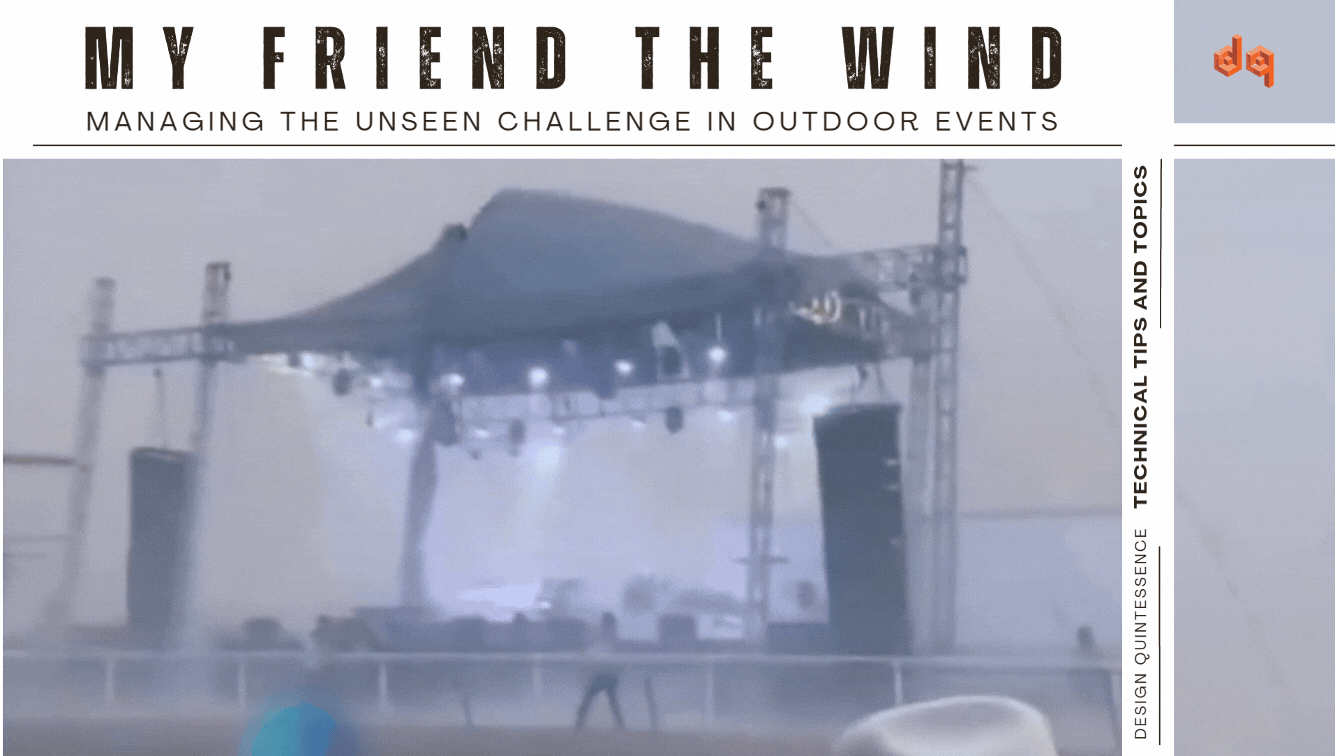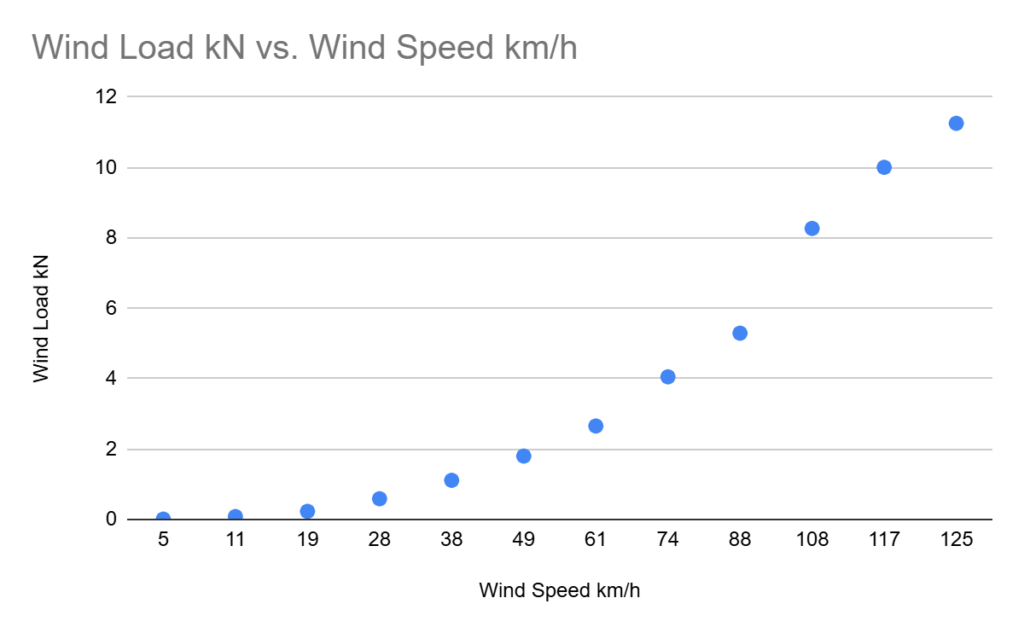The entertainment industry works in a multitude of environments. While a large portion of the events occur indoors in theatres and event spaces etc, there are also many events that are held outdoors, and this adds an extra level of complexity to our risk assessment and management procedures.
Possibly the biggest risk that we have to confront with outdoor events is the effect of wind on our structures and equipment.
Why is it windy?
We all experience wind daily, but what causes it and why does it fluctuate in strength?
In broad terms, wind is caused as air flows from areas of high pressure in the atmosphere, to areas of low pressure. These high- and low-pressure areas are formed as the different parts of the planet heat and cool. Higher heat causes air to rise and cooler air will move in to replace that rising air at the surface. The pressure zones also move around the planet as they interact with each other. The higher the difference between the two pressure areas (high to low) will create a higher wind speed as more air moves from the high-pressure area to the low-pressure area. This difference is known as the wind gradient.
The Coriolis Effect
This phenomenon is responsible for many large-scale weather patterns. The key to this is the earth’s rotation and the resulting rotational speed variation. i.e. faster at the Equator than at the Poles
This affects the movement of air between pressure systems.

Air movement is diverted clockwise creating an air flow- wind between the Isobars.
Learning how to read these weather charts can be an invaluable skill when it come to understanding what the wind is likely to do during your event. A good starting resource is the Bureau of Meterology website which has a wealth of information about the weather – The art of the chart: how to read a weather map – Social Media Blog – Bureau of Meteorology
Very general predictions from the high- or low-pressure systems as follows:
High pressure
Like to be clear skies, settled weather, and light winds
Low Pressure
Incoming air from the surrounding high-pressure systems will likely cause cloud buildup, possible rain and storms and stronger winds
Predicting the weather is critical to developing our plans and procedures for the period of the event; from load-in to load-out.
Using our own experience and knowledge in conjunction with the forecasting available from the Bureau of Meteorology can help us prepare.
A useful reference chart to keep to hand is the following Beaufort scale. This uses experimental assessment of the environment to estimate the site wind speed.
| Beaufort Wind Scale | |||||
| Wind Force | Description | Specifications | Wind Speed km/h (upper limit) | Wind Speed m/s | Wind Speed Kt |
| 1 | Light Air | Direction shown by smoke drift but not by wind vanes. Sea rippled | 5 | 1 | 3 |
| 2 | Light Breeze | Wind felt on face; leaves rustle; wind vane moved by wind. Small wavelets on sea | 11 | 3 | 6 |
| 3 | Gentle Breeze | Leaves and small twigs in constant motion; light flags extended. Large wavelets on sea | 19 | 5 | 10 |
| 4 | Moderate Breeze | Raises dust and loose paper; small branches moved. Small waves, fairly frequent white horses | 28 | 8 | 15 |
| 5 | Fresh Breeze | Small trees in leaf begin to sway; crested wavelets form on inland waters. Moderate waves, many white horses | 38 | 11 | 21 |
| 6 | Strong Breeze | Large branches in motion; whistling heard in telegraph wires; umbrellas used with difficulty. Large waves, extensive foam crests | 49 | 14 | 26 |
| 7 | Near Gale | Whole trees in motion; inconvenience felt when walking against the wind. Foam blown in streaks across the sea | 61 | 17 | 33 |
| 8 | Gale | Twigs break off trees, generally impedes progress. Wave crests begin to break into spindrift | 74 | 21 | 40 |
| 9 | Strong Gale | Slight structural damage (chimney pots and slates removed). Wave crests topple over, and spray affects visibility | 88 | 24 | 48 |
| 10 | Storm | Trees uprooted; considerable structural damage. Sea surface is largely white | 108 | 30 | 58 |
| 11 | Violent Storm | Accompanied by widespread damage. Medium-sized ships lost to view behind waves. Sea covered in white foam, visibility seriously affected | 117 | 33 | 63 |
| 12 | Hurricane/Cyclone | Devastation. Air filled with foam and spray, very poor visibility. (Speed listed is gusts for Cat 1 Cyclone) | 125 | 35 | 67 |
While the Beaufort scale is useful to estimate site wind speed, a wind speed measuring device set up on site and monitored is recommended. All structures and equipment must be engineered in accordance with local and national regulations. In Australia, there are different wind speed regions to consider.
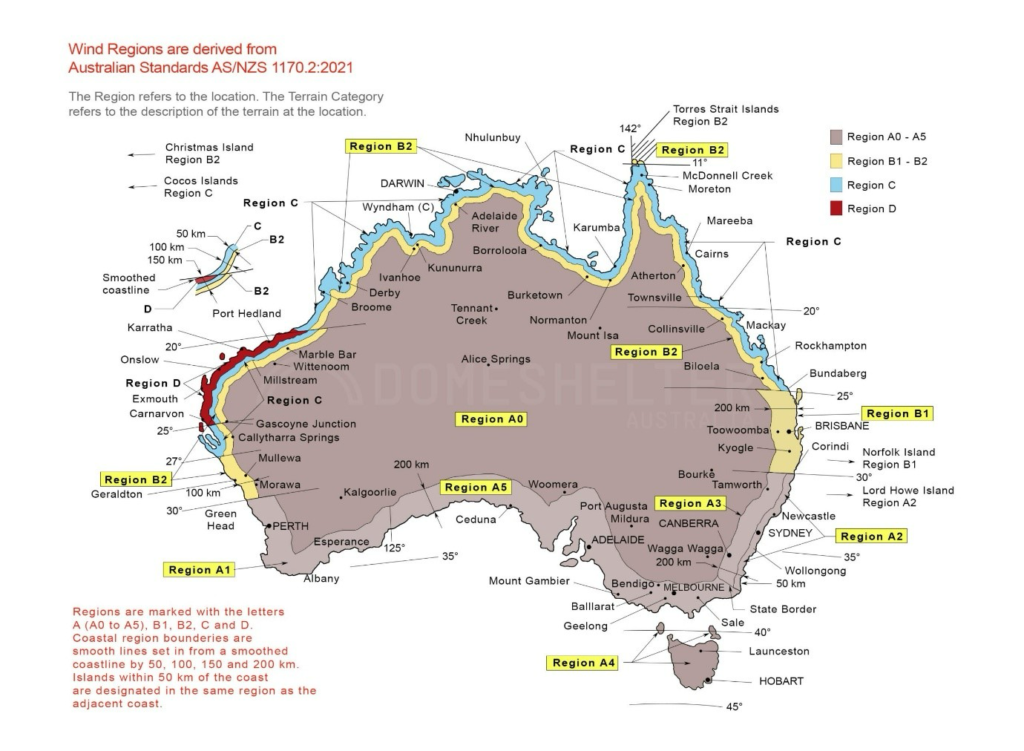
Consult with a qualified and suitable experienced structural engineer to determine the design wind for your structure based on the site.
Be aware that structural engineering checks to Code Loads can result in impracticalities that cannot be implemented within typical event production time frames and budgets. Plan to work with your engineer with a Wind Action Management Plan that can be tailored to your structure and an agreed site wind speed threshold.
What effect does wind have on our structures?
Consult with your engineer to determine a suitable design wind rating for your structure based on your use case scenario.
While the wind itself is invisible to our eyes, its effects are evident almost anywhere that you look. From rustling grass, to waving tree branches and flags, these effects of wind are a real physical force acting on the world around us, and our structures are acted on by the wind in the exact same way.
Air behaves like a fluid as it moves through our environment. If you imagine a river flowing downstream, so the wind flows from those high-pressure areas to the low-pressure areas. Any object that the wind meets will be like a rock in the river, or in some cases, like a dam. The wind will push against those objects, increasing in pressure until it finds a way to flow around them. It’s that buildup of pressure that concerns us most.
Unlike high end sports cars, our structures tend not to be aerodynamic marvels that shed wind easily. We often have large flat surfaces like LED walls, banners, or curtains, as well as big empty pockets like the internal area under a roof skin. These objects impede the flow of the wind and as a result, the wind will apply pressure to those objects creating additional loads on the structure above the existing equipment load.
This additional load needs to be considered when engineering the structures to ensure that there is sufficient strength in the structure to handle the equipment load as well as any potential wind loading that may occur.
Understanding the changing loads applied by wind
To get a clearer understanding of the loads that wind can apply to our structures, let’s look at some basic examples. For this example, we will consider a simple LED wall, 5m wide by 3m high, for a total area of 15m3 surface area.
To estimate these loads we will use the calculator available here – Wind Load Calculator
NOTE: This is not intended to be engineering advice or a replacement for proper structural engineering calculations for any structure.
Starting with a light breeze of only 10km/h (3m/s for simplicity). If we consider the angle of the screen to the wind at 90 degrees e.g straight on to the wind which is our worst case scenario we get a wind load of 0.083 kiloNewtons. This equates roughly to a 8.5kg force pushing against the screen.
If we take that wind speed a little higher, up to 6m/s, with no other changes, our wind load increases to 0.33kN or a 33kg force pushing on that screen.
And, for a strong breeze of 12m/s that jumps again up to 1.32kN or 134kg of force.
As we can see from these basic examples, the force acting on the structure increases exponentially as the wind increases. Even a small increase in wind speed will result in a significant increase in the loads applied to the structure.
This calculator does not take into account the drag coefficient of the structure and so while it can be used as an estimate, your engineer may need to use a higher coefficient depending on the particular structure. That shape of the structure may increase wind load as much as 2 times or more.
All these wind loadings, on screens, banners, canopies and even just the truss itself must be considered by engineers to calculate the total wind loading and then recommend maximum wind speed limits and other items such as bracing and ballast to protect the structure and its users from collapse.
What does the wind do to structures?
Wind acting on a structure will cause several reaction forces that can cause issues.
The wind will push on the structure, it will cause lifting of the structure and it will also add loads that the structure needs to dissipate.
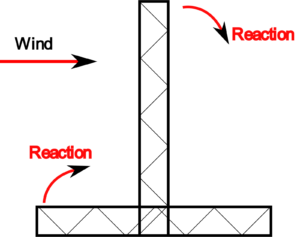
If we look at a typical “goal post” design LED support structure we can see that the wind pushes on the front of the structure which creates reaction forces that try to push the structure back and cause it to rotate backwards, lifting the front support. The turning moment on the upright truss will also add additional loads to that truss that could cause overload and failure.
How can we stabilise this structure? Lets look at the upright truss first.
To resist the wind load we can add bracing from the base to the upright. This bracing will provide a stiffness to the structure and help resist that wind loading. For upright towers, bracing is used to prevent the towers from bending. This bracing can be solid tube or truss bracing or it could be tensioned straps. The purpose of the bracing is to provide an opposing force to the pushing forces that are trying to move the towers.
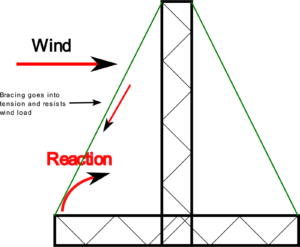
With the upright truss reaction forces addressed, we can now move to the reaction force that is trying to lift the front support leg.
Another addition to almost any structure is ballast. Often these are large concrete blocks attached to the structure at the base in positions designated by the engineer. They provide downforce and additional mass to the structure which helps to counter the lifting and pushing forces on the structure.
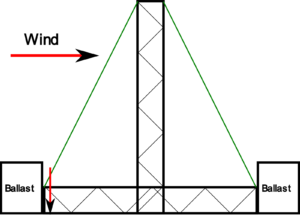
Adding this ballast weight, securely connect to the supports of the structure provides a way to counter the lifting forces and thereby stabilise the structure to prevent it from lifting and or tipping over.
As with all structures, the types of bracing and the amount of ballast must be specified by a qualified engineer.
Procedures to increase safety
Once we have consulted with engineers and obtained a structural report on our structure, we now need to ensure that we have appropriate procedures in place to manage the structure, monitor wind and have a plan for when the weather becomes an issue.
In your structural report you can ask the engineer to provide a wind safety plan which lays out the wind speed limits and the required actions at each increase of wind speed.
Ensure that you have a nominated person responsible for monitoring weather conditions, wind speed and that is aware of the actions required by the wind plan. All staff should know their role to carry out at each stage of the wind plan and be prepared to do so at the direction of the weather monitoring person.
Use radar from the BOM, wind speed meters and all available forecasting information to ensure that you are always aware of the wind.
NOTE: The contents of this article do not purport to be engineering advice or instructions. All structures should be evaluated by a qualified engineer prior to use and all aspects of that structural report should be followed.
DISCLAIMER: The information provided in this document is offered as a best practice guideline for consideration by experienced and competent personnel. No liability will be accepted for misuse or misinterpretation.

